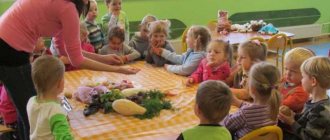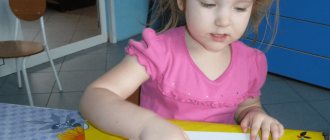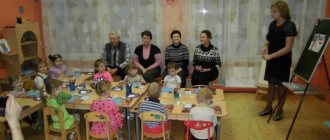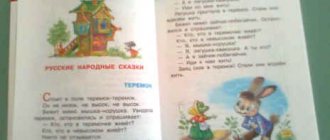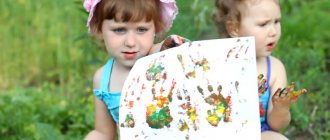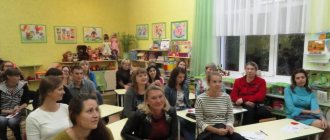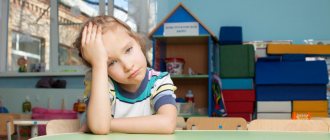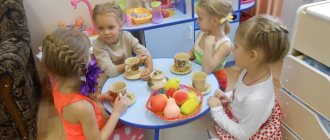Planning for the week in the second junior group. Topic: “Autumn (natural phenomena)”
Planning for the week in the second junior group
Theme of the week: Autumn (natural phenomena). Duration of the week : October 1 - 5. Goal: To create conditions for enriching children’s personal experience with knowledge, emotions and impressions about autumn; consolidate knowledge about the most typical features of autumn, about the phenomena of autumn nature, about vegetables, fruits, flowers. Continue to work on expressive speech through memorizing poems. Final event: Collective work “Carpet of autumn leaves”. Organization of a developmental environment: Bring in the necessary materials for independent activity in the experimentation corner (leaves, cones, twigs, etc.). Place paintings depicting autumn in the speech development corner Expand the topics of books in the book corner with encyclopedias for children “Seasons”, “All Year Round”; diversify educational games, introduce games: lotto “Vegetables and Fruits”, logical chain “Seasons”. in the corner of plot-role-playing games . in the activity corner . Musical corner: invite children to listen to T. Potapenko’s song “Falling Leaves”; “Sad Rain” (D. Kabalevsky). Interaction with parents: Inform parents about the theme of the week, invite them to participate in the “Gifts of Autumn” competition. Organization of educational activities Days of the week Monday 10/01/18 Morning Individual work on communication activities: Game situation “Let's say hello to the bear.” Goal: To teach children to be polite (teach them to say hello, say goodbye, thank you for their help). Game situation “Concert for a bear”. Goal: To involve children in role-playing interaction, to develop gaming skills. Conversation “Getting to know musical instruments” Purpose: To learn to distinguish musical instruments by appearance (drum, spoons, pipes, rattles, bells). Listening to the music of T. Popatenko “Falling Leaves”. Goal: To teach to listen to a song to the end, to understand the nature of music. Cultivate emotional responsiveness to music. Vocabulary work: sad, smooth, tender. Lessons 1. Speech development. "Hedgehog visiting the guys." Goal: To promote the development of dialogic and coherent speech. Activation and generalization of the dictionary. Development of fine motor skills and attention. Fixing flowers. Foster a desire to help the characters. Memorizing the poem “Autumn, autumn has come...” 2. Physical education. Develop orientation in space when walking in different directions; teach walking on a reduced area of support while maintaining balance. (L.I. Penzulaeva “Physical education in kindergarten. Second junior group”, September, lesson 1) Walk Edited by L.L. Timofeeva “Planning extracurricular activities with children during the day. Second junior group” p.48 No. 4 (morning, October). Individual work in physical education: Outdoor game “We built, we built.” Goal: To teach children to imitate the actions performed by builders, to develop independence and creativity when performing physical exercises. Reading fiction by S. Marshak “The Tale of a Stupid Mouse.” Tuesday 02.10.18 Morning Individual work on physical development: Outdoor game “Hen and Chicks.” Goal: To teach children to crawl under a rope, moving sideways, without touching the floor with their hands, to develop independence and creativity when performing physical exercises, and to learn to act together. Review of the album "Pets". Goal: Consolidating children’s knowledge about domestic animals and their cubs, developing the ability to reflect received information and impressions in speech. Looking at an album about the seasons. Theme: “Golden Autumn”. Reading: E. Golovin “Autumn”. Goal: To expand children’s ideas about autumn, about its period called “golden autumn”, to generalize knowledge about its characteristic features. Vocabulary work: autumn, golden, beautiful, magical, fabulous, wonderful, elegant, kind. Listening to music “Sad Rain” (D. Kabalevsky). Goal: Continue to develop emotional responsiveness to music. Learn to hear the expressive means of music: features of tempo, dynamics, timbre. Lessons 1. Mathematics. Strengthen the ability to distinguish and name a ball (ball) and a cube (cube), regardless of the color and size of the figures. (I.A. Pomoraeva “Formation of elementary mathematical concepts. Second junior group”, September, lesson 1) Walk Edited by L.L. Timofeeva “Planning extracurricular activities with children during the day. Second junior group” p.49 No. 4 (evening, October). Individual work on speech development: Teach children to understand general concepts on the topic “Pets”, teach them to recognize and name babies. Reading fiction by A. Pushkin “Wind, wind ...”, excerpt from “The Tale of the Dead Princess”. Wednesday 03.10.18 Morning Individual work on cognitive activity: Work in the book corner. Looking at illustrations. Goal: To teach children to use the book correctly and carefully. Didactic game “Whose baby?” Goal: To teach children to recognize and name baby domestic animals. Review of the album "Pets". Goal: To teach children to name the body parts of animals: head, torso, tail, legs, paws, to develop responsiveness, to teach them to see beauty and cuteness. Theatrical game "Turnip". Goal: To teach children to imitate the characteristic actions of fairy tale characters, following the plot of the fairy tale, to convey the emotional state of the characters. Lessons 1. Musical lesson. (according to the music director's plan). 2. Application “Autumn leaves”. Purpose: To learn to stick ready-made forms in certain parts of the base - sheet according to the sample; develop the emotional-volitional sphere (the desire to see things through to the end); cultivate independence and accuracy. Walk Edited by L.L. Timofeeva “Planning extracurricular activities with children during the day. Second junior group” p.51 No. 5 (evening, October). Individual work on FEMP: Didactic game “Whose house?” Goal: To teach to name and distinguish geometric shapes, to activate the corresponding area of the children’s vocabulary. Reading fiction by K. Balmont “Autumn”. Thursday 04.10.18 Morning Individual work on learning/repetition of poems: Memorizing the nursery rhyme “Night has come.” Purpose: To develop memory, teach children to expressively reproduce a short text by heart. Didactic game “Whose mother?” Goal: Continue to teach children to recognize and name baby domestic animals. Review of the album "Pets". Goal: To tell children about the benefits pets bring, to teach children to reflect their impressions in speech. Vocabulary work: domestic animals, animals, cow, dog, cat, body, tail, wool, etc. Theatrical game “Kolobok”. Goal: To teach children to imitate the characteristic actions of fairy tale characters, following the plot of the fairy tale, to convey the emotional state of the characters. Lessons 1. Drawing. "Autumn leaf fall." Goal: To teach children to paint with a brush using the “dipping” method, changing the color of the paint; learn to distinguish and name colors; develop speech and thinking; develop the ability to work together. 2. Physical culture. Repetition of previous material. Develop orientation in space when walking in different directions; teach walking on a reduced area of support while maintaining balance. (L.I. Penzulaeva “Physical education in kindergarten. Second junior group”, September, lesson 1) Walk Edited by L.L. Timofeeva “Planning extracurricular activities with children during the day. Second junior group” p.53 No. 7 (morning, October). Individual work on ecology: Experimentation: loosening sand. Goal: Continue to acquaint children with the properties of sand: loose, crumbly, learn to reflect the impressions received in speech. Vocabulary work: sand, wet, crumbly, loose, dry. Reading fiction by A. Koltsov “The Winds Blow” (from the poem “Russian Song”). Friday 05.10.18 Morning Individual work on visual arts: Didactic game “Funny Pencil”. Goal: Learn to hold a pencil correctly in your hand; draw sticks straight, vertical. Didactic game “Who lives in the house?” Goal: To consolidate and use children’s knowledge about domestic animals in play activities. Looking at an album about autumn. Goal: Based on paintings by various artists, postcards, and children’s drawings contained in the album, to form children’s ideas about the characteristic features of autumn. Vocabulary work: falling leaves, trees, bare, cold, first snow. Didactic game “Guess who called?” Goal: Development of auditory perception and attention of children, the ability to recognize a person by voice. Lessons 1. Musical lesson. (according to the music director's plan). 2. Cognitive development. Construction. “We’re building Mashenka’s fence.” Goal: To consolidate the skill of accurately connecting parts and lining them up in an even line (path, fence along it) during the game. Fix the names of the main parts. Introduce rhythmic alternation in the construction of bricks (on the short, narrow side) and a cube. Teach children to correlate their actions with instructions and models. Walk Edited by L.L. Timofeeva “Planning extracurricular activities with children during the day. Second junior group” p.54 No. 7 (evening, October). Individual work on physical education: Outdoor game “Run to me.” Goal: To train children to run in a certain direction, continue to teach them how to navigate in space, and act in accordance with the rules of the game. Reading fiction Poem by E. Lavrentieva “Friendly Kitten.”
We recommend watching:
Calendar - thematic planning in the second junior group for December Calendar - thematic planning in the second junior group for November Long-term plan for working with parents in the second junior group Educational program of additional education of artistic and aesthetic orientation for
Similar articles:
Planning classes on FEMP in the second junior group according to the Federal State Educational Standard for a year
Indoor games in kindergarten in the fall. Junior group
Calendar planning in the junior group "Autumn"
love mohammed
Calendar planning in the junior group "Autumn"
Theme of the week: " Autumn "
Goal: To expand children’s ideas about autumn - the concept “Golden Autumn ”
.
Consolidate knowledge about the rules of safe behavior in nature; To form generalized ideas about autumn as a season , the adaptability of plants to changes in nature, natural phenomena;
Expand your understanding of inanimate nature; Foster a caring attitude towards nature; To form elementary ecological ideas of preschoolers in various educational areas. Final event: Entertainment “Hello, Autumn ”
.
Y/N
Mode Joint activities between adults and children Educational activities during restricted periods Organizing a developmental environment for children’s independent activities Working with parents
Subgroup/group
Individual
10.28.19., Monday Morning Reception of children.
Conversation with children on the topic: “Golden Autumn ”
.
Goal: continue to teach children to see characteristic changes in nature with the arrival of autumn .
Looking at pictures on the topic “Golden Autumn ”
Goal: To consolidate the ability to look at illustrations.
D/I “Who is this? What is this?"
Goal: Name words denoting animate and inanimate nouns.
Morning exercises. No. 9 Individual work on artistic activities.
Goal: to cultivate accuracy in working with paints. P/U “I myself”
.
Goal: to consolidate the ability to eat carefully, improve food culture skills; teach children to hold a spoon correctly, eat and drink food without spilling, and chew thoroughly. Organize children to play with their favorite toys. Goal: teach them to play together in a group. Parental consultation “ “If a child often throws tantrums”
»
GCD 1. Acquaintance with the social world (OSM)
.
"Admiring the beauty of autumn "
.
Program objectives: to consolidate children's ideas about autumn signs ; replenish and activate children's vocabulary using adjectives; develop creative imagination, the ability to quickly navigate a plane, and form a whole from parts; contribute to the emergence of an emotionally rich atmosphere. (Abstract)
2. Musical activities. Music.
Program objectives: teach children to start moving with the beginning of the music and end with its end; cause activity when singing along and singing; develop a sense of rhythm.
Walk Watching leaf fall
Objectives: learn to identify the signs of autumn ;
develop observation skills;
to cultivate the ability to enjoy the beautiful, to treat nature with care.
P/I “Sparrows and the car”
.
Goal: to consolidate knowledge about traffic rules and spatial orientation.
P/I “Find your house”
.
Goal: to teach how to quickly act on a signal, to teach how to navigate in space.
Labor: putting toys back in place. Purpose: to teach children to maintain order. Individual work on the development of ATS. Goal: development of movements (standing jumps)
P/U
“Clean!”
.
Goal: to teach children to take care of their appearance, to cultivate neatness and independence.
Organize children's play with external materials.
doll, cars, steering wheels.
Work before bed Reading: “The Uncooperative Hoopoe”
,
“Help!”
lane from Czech S.Marshak Goal: to develop the ability to listen to the teacher.
2nd half of the day
Walk Gradual rise of children.
Gymnastics after sleep. Walking on massage mats.
Creating a game situation “We have guests”
Goals: to promote the development of children’s ability to play together.
Offer children printed board games Goals: to cultivate perseverance and attention.
P/I “Sparrows and the car”
.
Goal: to consolidate knowledge about traffic rules and spatial orientation.
P/I “Find your house”
.
Goal: to teach how to quickly act on a signal, to teach how to navigate in space.
Individual work on speech development. Call me kindly"
Goal: expansion and activation of children's vocabulary. Learn to form words with the suffixes “chk-chn”
Situational conversation “Shoes in places”
.
Goal: to develop self-care skills in children, to teach them to carefully place their shoes near the crib, and to put on their shoes independently after sleep. Remote material.
Steering wheels, emblem masks, toys, chalk, cars.
Y/N
Mode Joint activities between adults and children Educational activities during restricted periods Organizing a developmental environment for children’s independent activities Working with parents
Subgroup/group
Individual
29.10.10.19., Tuesday Morning Reception of children.
DI. "Help me find my mom"
Goal: To consolidate the correct pronunciation of sounds. Exercise in the formation of the grammatical structure of speech.
Observation in the center of nature: loosening the soil. Purpose: explain why this procedure is needed, cultivate a love for nature
Morning exercises No. 9 Individual work on sensory development. D/I “Hide the butterfly”
Goal: Continue to introduce children to the four primary colors, teach them to distinguish and name them. Pronouncing the nursery rhyme “Water, water, wash my face”
— while washing. Goals: to continue the formation of the CGN, to develop speech.
Lego
constructors to play with. Goal: to develop constructive abilities.
Conversation “If a child often throws tantrums
.
GCD 1. Cognitive and research activities. (FEMP)
Lesson No. 9
Program tasks: Develop the ability to find an object in space, consolidate the ability to use the words “so much”
,
“equally”
, cultivate curiosity and perseverance.
(V.P. Novikova “Mathematics in kindergarten”
p. 22)
2. Motor activity. Physical Culture
Program tasks: Exercise in maintaining balance when walking on a limited area of support; develop the ability to land on bent legs when jumping. L. I. Penzulaeva “Phys. Classes in kindergarten. Second junior group »
page 33
Walk Bird Watching
Goals: continue observing birds in the area; learn to distinguish the main parts of the body;
develop and cultivate a caring attitude towards birds.
P/I “Sparrows and the cat”
.
Goals: to teach to jump gently, bending your knees; to teach to be careful when taking up space, not to push a friend
P/I “Get in the circle”
.Goals: improve the ability to operate with different objects; develop eye and dexterity.
IMP “Pass the ball”
.Goals: develop the ability to pass the ball from hand to hand.
Labor: cleaning up large debris on the site.
Goal: to cultivate hard work. Individual work on the development of ATS. Goal: to develop the ability to throw objects in a certain direction with both hands. Situational conversation “I’m learning to do everything myself!”
.
Goal: to continue to encourage children to dress and put on their own shoes, to be friendly to each other, and to develop communication skills.
Organize children's play with blocks and sports equipment. Goal: to develop motor activity and imagination.
Work before bed Reading: “Nanny Fox”
, trans. from Finnish E. Soini Purpose: to explain to children the actions of the characters and the consequences of these actions.
2nd half of the day
Walk Gradual rise of children.
Gymnastics after sleep.
Walking on massage mats.
Learning poems about toys. Goal: to develop children's memory and speech.
Create a condition for organizing the s/r game “Preparing a treat for the dolls”
Goal: continue to teach children to play together in a team.
P/I “Sparrows and the cat”
.Goals: learn to jump softly, bending your knees; don't push your friend
P/I “Get in the circle”
.Goals: improve the ability to operate with different objects; develop eye and dexterity.
IMP “Who will pass quietly”
Objectives: to familiarize with walking in a given direction, to develop the ability to maintain balance.
Individual work on FEMP. D/I “When it happens”
(parts of the day)
Purpose: to consolidate the idea of the parts of the day, to teach how to correctly use the words “morning”
,
“day”
,
“evening”
,
“night”
.
Situational conversation “Where is my high chair?”
.
Goal: to teach children to find their chair, to take it correctly and carefully place it near the table, to introduce children to the rules of safe behavior in a group . To offer children games with large building materials. Goals: to promote the formation of the ability to carry out various constructions, to encourage them to play with buildings, to make them stable.
Y/N
Mode Joint activities between adults and children Educational activities during restricted periods Organizing a developmental environment for children’s independent activities Working with parents
Subgroup/group
Individual
10.30.19., Wednesday Morning Reception of children.
Conversation “We don’t like rude people and brawlers”
.
Goals: to provide conditions for the moral education of children, to teach them to evaluate actions and express their opinions about various actions.
D/I “What time of year?”
Goal: to teach children to understand weather changes by season, plant behavior and
animals, as well as the lives of people at different times of the year.
Finger game "Cabbage"
.Goals: learn to pronounce nursery rhyme words, develop fine motor skills.
Morning exercises. No. 9 Individual work on musical activities. “What sounds” Goal: Continue to teach how to isolate and recognize the sounds of individual instruments. Introduce children to the sounds of the world around them, teach them to isolate and recognize them. P/U “Dry sleeves”
.
Goal: to develop the ability to wash hands carefully, roll up sleeves, not spill water on the floor, and wipe them dry with a personal towel. Organize children's play with household toys. Goal: teach them to play together in a group. Booklet “Family evening”
GCD 1. Visual activity. (Modeling)
Topic: “Big and small birds sit on the feeder”
Program objectives: to continue to develop in children the desire to convey images of birds in sculpting, correctly conveying the shape of the body, head, and tail. Reinforce sculpting techniques. Develop the ability to talk about what was blinded. Foster creativity, initiative, and independence. Develop imagination. (T. S. Komarova, “Art activities in kindergarten”
, page 84)
2. Musical activities. Music
Program objectives: teach children to start moving with the beginning of the music and end with its end; cause activity when singing along and singing; develop a sense of rhythm.
Walk Observation of the roadway
Objectives: to introduce the roadway - highway; give an idea of the rules of the road.
P/I “Sparrows and the car”
.
Goal: to teach children to run quickly when given a signal, but not to bump into each other, to start moving and change it according to a signal from the teacher, to find their place.
P/I “Sparrows and the cat”
.Goals: learn to jump softly, bending your knees; don't push your friend
Offer children balls and skittles. Goals: to develop physical activity.
Labor: sweeping paths.
Goal: to cultivate a desire to help adults. Individual work on the development of ATS. Goals: to practice catching and throwing a ball with both hands. Situational conversation about the rules of behavior at the site. Goal: to cultivate in children a friendly attitude towards each other, to facilitate the establishment of emotional contact. Organize children's play with outdoor materials (balls, ribbons, flags)
.Goal: to teach children to play together and develop physical activity.
Work before bed Reading:
Ah, Pushkin. “Wind, wind! You are powerful."
Goal: to teach children to listen to short excerpts of works.
2nd half of the day
Walk Gradual rise of children.
Gymnastics after sleep.
Walking on massage mats.
Theatrical game on the river. n. fairy tale "Mitten"
Goals: To teach children to communicate freely and easily enter into dialogue.
Organize a s/r game “Treats for guests”
. Purpose: to teach children to participate in the game, perform simple game actions,
P/I “Birds in nests”
.Goals: teach to walk and run, scattered, without bumping into each other
P/I “Find your house”
.Goal: to teach to act quickly on a signal,
Individual work on art activities. Goals: continue to develop the ability to hold a brush correctly, dip it in paint, and rinse it. P/U “Scented soap”
.
Goal: to encourage children to independently take soap from a soap dish, rub their palms, rinse off the soap, and know the location of their towel. Games with external material based on interests. Goals: to cultivate the desire to play in a team, not to quarrel.
Y/N
Mode Joint activities between adults and children Educational activities during restricted periods Organizing a developmental environment for children’s independent activities Working with parents
Subgroup/group
Individual
10.31.19., Thursday Morning Reception of children.
"Conversation about fire safety rules"
Goals: to teach children to coherently answer the teacher’s questions; correctly use the names of objects in speech; activate prepositions and verbs in sentences; introduce children to fire safety rules.
D/I according to FEMP “Find out by shape”
Goal: learn to compare the shapes of objects with geometric patterns.
Morning exercises. No. 9 Individual work on speech development: D/I “Who does what?”
Purpose: to introduce words denoting action. Learn to use verbs in speech and ask questions to them correctly. Situational conversation “Dry sleeves”
.
Goal: to develop the ability to wash hands carefully, roll up sleeves, and not spill water on the floor. Offer children a wooden construction set. Purpose: to develop children’s constructive abilities. Consultation “The role of the family in the physical education of a child”
.
GCD 1. Visual activity (Drawing)
Topic: "It's Raining"
Program objectives: To develop children’s ability to convey impressions of the life around them in a drawing, to see an image of phenomena in a drawing. Develop the ability to draw short strokes and lines, hold a pencil correctly. To instill in children a desire to draw.
(T. S. Komarova, “Art activities in kindergarten”
, page 46)
2. Motor activity. Physical education P/W: Exercise in maintaining balance when walking on a limited area of support; develop the ability to land on bent legs when jumping. L. I. Penzulaeva “Phys. Classes in kindergarten. Second junior group »
page 33
Walk Looking at an autumn tree
Goal: to develop knowledge about the main parts of wood, their height and thickness.
P/I “Bird in the Nest”
.
Goals: to learn to walk and run in all directions without bumping into each other;
P/I “Find your house”
.Goal: to teach how to quickly act on a signal and navigate in space.
Labor: Cleaning toys. Goal: to develop the ability to maintain cleanliness and order in the area, encourage to provide assistance to adults. Individual work on the development of ATS. Goals: to learn to jump on two legs, moving forward; to develop dexterity, self-confidence. P/U "Bashmachki"
.
Goal: to teach students to independently unfasten and fasten Velcro fasteners, and practice using other types of fasteners. Organize children's play with cars, blocks, construction sets. Goal: teach them to play together and share toys. Show children how to play around with buildings.
Work before bed Reading: G. Tsyferov. "About Friends"
from the book
“About the Chicken, the Sun and the Little Bear”
) Goal: to develop the ability to listen to new works and follow the development of the action.
2nd half of the day
Walk Gradual rise of children.
Gymnastics after sleep.
Walking on massage mats.
Help organize a S/R game. “We are building a garage for cars”
.Goals: learn to perform simple game actions, communicate with peers.
Entertainment “Hello,
Autumn ” . Goals: To expand children’s ideas about
autumn - the concept of “Golden
Autumn ” , to develop the skills of caring for nature.
P/I “Bird in the Nest”
.
Goals: learn to walk and run in all directions without bumping into each other.
"Find your house"
.Goal: to teach how to quickly act on a signal and navigate in space.
ISP “Pass by, don’t hurt me”
.Goals: to develop orientation in space.
Individual work on cognitive development D/I “What time of year?”
Goal: To teach children to understand weather changes by season, the behavior of plants and animals, as well as the lives of people at different times of the year.
P/U “Neat hairstyle”
.
Goal: to teach children to use an individual comb and control their appearance using a mirror. Remote material
Steering wheels, toys, chalk, cars.
Y/N
Mode Joint activities between adults and children Educational activities during restricted periods Organizing a developmental environment for children’s independent activities Working with parents
Subgroup/group
Individual
11/01/19, Friday Morning Reception of children.
Work on ZKR “Horses Clatter Their Hooves”
Goal: To develop phonemic hearing, develop children’s speech attention.
Music -did. game “What Sounds” Goal: Continue to teach how to isolate and recognize the sounds of individual instruments.
Finger gymnastics “Castle”
.Goal: to develop fine motor skills.
Morning exercises No. 9 Individual work on cognitive development. DI
“What is where?”
Objectives: to consolidate knowledge of the need to maintain order in the group ;
clarify knowledge about the arrangement of objects in a group .
F/S “I’m already big!”
.
Goal: to consolidate the ability to sit correctly at the table, eat carefully, take food only with a spoon, use a napkin; improve food culture skills. Organize games with lacing, mosaics, puzzles. Goal: develop fine motor skills and logical thinking.
GCD 1. Speech development
Topic: “Reading A. Blok’s poem “Bunny”
.
Memorizing A. Pleshcheev’s poem “
Autumn has come... ” .
Program objectives: To develop children’s ability to remember A. Pleshcheev’s poem “ Autumn has come ”
.
When perceiving A. Blok’s poem “Bunny”
.
To form in children sympathy for the bunny, who is cold, hungry and scared in the uncomfortable autumn season .
Cultivate a love for nature. (V.V. Gerbova, “Classes on speech development”
, page 38)
2. Motor activity. Physical Culture
Program tasks: Exercise in maintaining balance when walking on a limited area of support; develop the ability to land on bent legs when jumping. L. I. Penzulaeva “Phys. Classes in kindergarten. Second junior group »
page 33
Walk Target walk: excursion around the territory of the kindergarten.
Goal: to form an idea about changes in nature in the fall , to form ideas about the changes occurring in nature
.P/I “Bird in the Nest”
.
Goals: to learn to walk and run in all directions without bumping into each other; to help each other.
P/I “Find your house”
.Goal: to teach how to quickly act on a signal and navigate in space.
ISP “Pass by, don’t hurt me”
.Goals: to develop orientation in space.
Folk game “Game: “The little gray bunny sits and wiggles his ears...”
.Goals: learn to repeat the words of a nursery rhyme, repeat movements.
Labor: cleaning up large debris on the site. Goal: to cultivate hard work. Individual work on the development of ATS. Goals: to develop dexterity in a game task with a ball. "Dressing and undressing"
.
Goal: to consolidate the ability to unfasten and fasten Velcro fasteners, continue to teach to follow the rules of behavior in the locker room, and ask for help using polite words. Organize children to play with their favorite toys. Goal: teach them to play together and share toys with each other.
Work before bed Reading: G. Tsyferov. "When there aren't enough toys"
from the book
“About the Chicken, the Sun and the Little Bear”
) Goal: to develop the ability to listen to new works and follow the development of the action.
2nd half of the day
Walk Gradual rise of children.
Gymnastics after sleep.
Walking on massage mats.
Household work. Putting things in order in the play center. Goals: to teach how to place toys in their places, to cultivate hard work. Offer children felt-tip pens and wax crayons. Goals: to develop imagination and fine motor skills.
D/I Help me find my mom.”
Goal: to teach to distinguish and name animals and their young, poultry and their chicks. Reinforce the correct pronunciation of sounds. Develop intonation expressiveness.
IMP “Who will pass quietly”
Objectives: to familiarize with walking in a given direction, to develop the ability to maintain balance.
Individual work on speech development. D/I “Call it affectionately”
Purpose: To introduce the structure of words in the process of forming nouns with diminutive suffixes. P/U “We are big”
.
Purpose: to put on shoes, distinguish between the right and left shoe; develop self-care skills. Offer children takeaway material.
Steering wheels, emblem masks, toys, chalk, cars.
Planning “Golden Autumn has come to visit us” in the second junior group
Tatiana Nedeva
Planning “Golden Autumn has come to visit us” in the second junior group
PLANNING EDUCATIONAL WORK 01.10.18 – 05.10.18
Group : 2 junior
Theme of the month: " Autumn "
Topic of the week: “ Golden autumn has come to visit us ”
Goal: To promote the accumulation of ideas about autumn as a time of year . Signs of autumn , autumn months , nurturing the desire to see the beauty of nature.
Final event: “ Autumn ”
Day of the week Mode Joint activities of adults and children, taking into account the integration of educational areas Organization of a developing environment for children’s independent activities Interaction with parents and social partners
Group , subgroup Individual
Monday 01.10.18 Morning Morning exercises.
Goal: To develop in children the habit of doing physical exercise in the morning.
Objectives: – Strengthen motor skills;
– Develop children’s physical qualities and abilities
KGN: Continue to teach how to use soap correctly and wash your hands carefully.
ZKR: “Fun Zoo”
.Goal: Development of the articulatory apparatus. Objectives: to teach children to correctly perform exercises for the tongue and lips.
Finger gymnastics. “A turtle walked across the field”
Goal: development of fine motor skills. Objectives: teach children to correlate actions with text.
D/i: “Let’s help the doll get dressed for a walk”
Goal: to teach children to distinguish and correctly name items of clothing and shoes. A conversation about the need to put toys in their places.
The goal is to teach children to be neat; take care of your things. (Arina, Tasya, Egor)
D/i “When it happens”
.
(Learn to correlate descriptions of nature in poetry and prose with a certain time of year, justify your choice using sentence structures) Games initiated by children.
Looking at illustrations
"Walk in the autumn forest . Trees (to activate children’s speech activity)
Doll Remind parents not to give their children sweets before breakfast and to make sure there is a change of clothes in the lockers.
GCD 1. Motor activity.
L. I. Penzulaeva lesson 5, p. 28.
Goal: To practice maintaining balance when walking on a limited area of support: to develop the ability to land on bent legs when jumping.
2. Cognitive - research activities.
Theme: " Autumn "
.Goal: to introduce children to
autumn phenomena in nature . Clarify the adaptations of birds and animals in the conditions of a given season. Consolidate knowledge about a person’s autumn clothing . Develop children's emotional responsiveness. See Volchkova p. 62 We teach how to land on bent legs when jumping. (Masha, Danil R, Tanya)
– Learning to listen to an adult’s speech without being distracted (Egor, Arina, Misha)
.
– We encourage you to participate in the discussion Alice, Mila Cords, 2 boards, ball
Poem by A. Fet “ Autumn ”
«Autumn leaves»
for each child
Monday 01.10.18 Walk
- Observation of the weather. Purpose: Note what the weather is like, teach children to use the corresponding concepts in speech, develop observation skills
-Active game: “Run to me”
.Goal: to develop the ability to navigate in space.
- Labor. Invite the children to collect dry branches on the site.
Goal: to teach children to work and help adults.
Situational conversation about the signs of autumn , remember the proverb “Without labor, there will be no fruit”
(learn to understand the figurative meaning of the proverb)
Find the tree that is the most elegantly dressed on the site
Ball games
Sand games
Children's independent games with outdoor toys.
Work before bed - asking riddles about vegetables and fruits;
- talking about table manners (using napkins, tablespoons and teaspoons)
;
- talk about the benefits of daytime sleep.
Evening
Gymnastics for waking up after a nap
Goal: promote quick awakening after sleep, improve health.
Independent play activities in corners.
Objectives: Learn to find activities of interest, play
together, to cultivate friendliness and tolerance.
D/i “Gathering the Harvest”
(teach children to recognize depicted objects by outline, practice classifying objects according to characteristics: mushrooms, berries, vegetables, fruits, etc.)
Walk
Observations: soil (expand children’s understanding of the soil and its inhabitants. Talk about what transformations will occur with fallen leaves in the soil, activate cognitive interest)
P/i "Day-Night"
Experimental games with sand
(teaching how to collect sand up a hill after playing, putting toys back in place)
Independent play activities for children with outside materials
Day Mode Joint activities of adults and children, taking into account the integration of educational areas Organization of a developing environment for children’s independent activities Interaction with parents and social partners
Group , subgroup Individual
Tuesday 02.10.18 Morning Morning exercises. Complex No. 3.
Goal: To develop in children the habit of doing physical exercise in the morning.
Objectives: – Strengthen motor skills;
– Develop children’s physical qualities and abilities
Conversation. Features of autumn nature : cold, windy, so people put on warm clothes, foliage flies from the trees, the goal is to expand ideas about the characteristic features of autumn nature .
Finger gymnastics “ Autumn breeze ”
Goal: development of fine motor skills and speech.
Didactic game “Collect yellow leaves”
Goal: to form color perception, encourage children to participate in joint activities. Looking at books “how animals scream.” Purpose: exercise in sound pronunciation of vowels A, O (Dima, Sasha, Masha)
D/i “What Mishutka brought us”
Goal: to consolidate the names of familiar vegetables and fruits.
(Anya, Angelina, Egor)
Dummies of leaves, fruits, vegetables in a basket, soft toy Teddy Bear. Recommend to parents to reinforce the rules of behavior in nature (do not tear plants unnecessarily, do not break tree branches, do not touch animals, etc.);
GCD 1. FEMP.
Topic: “Properties of objects. Count to two"
.
Goal: to develop the ability to identify and compare the properties of an object
tov, find the general property of objects. Mastering counting
up to two based on comparison of two sets containing
sharing 1 and 2 elements, establishing equality between them
by adding and subtracting units. Develop the cape
literal operations, speech, temporary representations.
2. Musical development.
According to plan . We encourage Adeline to collaborate with children.
Reinforcing knowledge of flowers with Danila. Leaves from trees green and red (yellow)
colors, 2 tables on a landscape sheet with a drawing of an umbrella, colored pencils,
umbrella, sun
.
Tuesday 02.10.18 Walk Looking at the flower bed. Chamomile, marigolds. Color, size, reading a poem h. Alexandrova “Little sun on my palm”
.Goal: to expand children’s understanding of the plant world, to familiarize them with flowers; develop and name two flowering plants by color, size, draw their attention to their coloring,
Labor in nature
Digging up marigolds. Goal: to develop labor skills, the ability to use a spatula correctly. Foster a desire to participate in plant care.
Physical activity. Physical improvement. basic movements: regular running, running in all directions, running on a signal. P/i "Car and sparrows"
.
Goal: To teach children to accurately perform game actions
Game exercise. "We jump, we stomp"
Goal: improve jumping on two legs while moving forward.
Alice, Eva, Alicia.
Remote inventory
Work before bed Reading your favorite book.
D/i “Let’s show the doll Masha how to undress”
(learn to remove tights first from the upper body, then from the legs, hang your clothes on the chair correctly
Evening Gymnastics of awakening, walking along massage paths.
D/i “You need to put things away - you don’t have to look for them”
(develop a caring attitude towards toys, put them back in their place, do not break them)
Conversation about rules of conduct in the forest.
Goal: to continue to form basic ideas about ways of interacting with plants and animals.
Drawing “What grows in the garden?”
Individual tasks: take one toy
(many toys),
colored pencils, drawing paper.
Walk Observation of weather phenomena, characterize the weather conditions with children (sunny, cloudy, rainy, windy, highlight weather features characteristic of autumn )
P/i "Rain"
Experimental games with sand.
Independent play activities of children with external materials.
Work. Putting the area in order.
Day of the week Mode Joint activities of adults and children, taking into account the integration of educational areas Organization of a developing environment for children’s independent activities Interaction with parents and social partners
Group , subgroup Individual
Wednesday 03.10 Morning Morning exercises. Complex No. 3.
Goal: to develop physical qualities, promote the accumulation and enrichment of children’s motor experience, and create the need for physical activity. improve children's health.
Reading the poem "Flowers"
V. Volina.
Riddles (Leaf Fall)
D/I “Which branch are the kids from?”
P/I "Bun"
Goal: uplifting mood. Help children understand the content of the work by relying on visualization. Developmental centers Invite parents to learn poems about autumn .
GCD 1. Motor activity.
L. I. Penzulaeva lesson 5, p. 28.
Goal: To practice maintaining balance when walking on a limited area of support: to develop the ability to land on bent legs when jumping.
2. Modeling “Canning fruits”
Goal: to consolidate children’s ideas about preparing for the winter; formation of interest in modeling.
We teach how to land on bent legs when jumping. (Masha, Danil R, Tanya)
We teach Anya, Angelina, Sasha to roll plasticine between their palms. Cords, 2 boards
Plasticine, modeling boards, napkins, doll to play with
Walk - Observation: leaves on trees. Goal: to encourage children to see beauty in natural phenomena, to update knowledge about flowers.
P/game “Sun and Rain”
.Goal: maintain interest in physical activity.
Situational conversation “Good and bad deeds”
.
Goal: to form in children ideas about norms of behavior, to teach them to see positive and negative character traits, to promote the establishment of friendly relationships. Labor. Invite children to collect sticks in the area
Goal: to teach children to carry out joint work activities. Learning with Misha and Arina the counting rhymes: 1,2,3,4,5 we can’t count our friends. Independent activity of children on a walk with external materials (sand sets, balls, transport)
. Games at the request of children.
Wednesday 03.10 Evening Awakening gymnastics, walking along massage paths.
Communication game “Friendly couple”
Goal: to teach children to act in concert.
Game "Who's Missing?"
S.R. And “Bake pies”
Goal: to introduce children to the process of making pies and safety rules in the kitchen; teach to set game goals, perform appropriate game actions, find objects necessary for the game in the environment, lead children to independently create game plans; develop gaming skills and abilities, enrich vocabulary; cultivate respect for other people's work; consolidate the ability to unite into groups in the game , perform game actions.
Conversation with children Egor and Anya on the topic “Walk in the garden”
.
Equipment for a doll's corner for parents and children - watching the leaves fall. Goals: walk along the leaves with the children, listen to them rustle, pay attention to the color and shape, arrange a fireworks display from the leaves; feel the coolness of fallen leaves, their rough surface, run your fingers along the edge of the leaf, examining its shape; compare leaves by size.
Walk Observations: soil (expand children’s understanding of the soil and its inhabitants. Talk about what transformations will occur with fallen leaves in the soil, activate cognitive interest)
P/i "Day-Night"
Experimental games with sand
(teaching how to collect sand up a hill after playing, putting toys back in place)
Independent play activities for children with outside materials
Exercise children in running. Remote equipment
Day of the week Mode Joint activities of adults and children, taking into account the integration of educational areas Organization of a developing environment for children’s independent activities Interaction with parents and social partners
Group , subgroup Individual
Thursday 04.10 Morning Morning exercises. Complex No. 3.
Goal: to develop physical qualities, contribute to the accumulation and enrichment of children’s motor experience,
KGN: Continue to teach how to use soap correctly and wash your hands carefully.
ZKR: “Fun Zoo”
.Goal: Development of the articulatory apparatus. Objectives: to teach children to correctly perform exercises for the tongue and lips.
Finger game “In the garden”
.
Target. Development of fine motor skills of the hands.
Strengthening hand washing skills Anya, Danil, Individual consultations upon request.
GCD 1. Speech development Topic: “Admiring the beauty of autumn ”
.
Purpose: coherent speech: activation of adjectives. Descriptive
stories about natural phenomena based on your personal impressions;
sound culture of speech: consolidating the pronunciation of sounds
[a], [and], [and], [n], [n*]; vocabulary and grammar: activation of adjectives and verbs. Volchkova, from 65
2. Motor activity. L. I. Penzulaeva lesson 5, p. 28.
Goal: To practice maintaining balance when walking on a limited area of support: to develop the ability to land on bent legs when jumping.
We teach how to land on bent legs when jumping. (Masha, Danil R, Tanya)
Teddy bear toy
Story pictures
Cords, 2 boards, ball
Walk Watching the sun. Goal: To introduce children to the phenomena of inanimate nature: changes occurring with the sun “it has become colder; the day is shorter"
.
Didactic game “Lay it out yourself”
. Target. Develop skills in laying out sun stones; development of fine motor skills of the hands.
Farm "Harvest"
. Target. Teach children to stand in a circle, make it wider, narrower, teach them to coordinate their movements with the spoken words.
Playing with sand. Cleaning equipment after games. Individual physical exercises with Anya, Sasha, Adelina - high jumps on the spot. Target. Development of movements.
Thursday 04.10 Evening Gymnastics after sleep “Walk in the forest”
Goal: promote quick awakening after sleep, improve health.
Independent play activities in corners.
Objectives: Learn to find activities of interest, play
together, to cultivate friendliness and tolerance.
SRI "Toys at the doctor"
Goal: to teach children how to care for the sick and use medical instruments, to cultivate attentiveness and sensitivity in children, to expand their vocabulary: introduce the concept of “hospital”
,
“sick”
,
“treatment”
,
“medicines”
,
“temperature”
,
“hospital”
.
"Dangerous Items"
.
.
” Conversation about the rules of behavior in the group . Individual work - looking at autumn paintings with Artyom , Alena, Danila.
Target. Study carefully, look at the picture, answer questions.
Children's development zones
Introducing parents to outdoor games recommended for use with children of primary preschool age.
Walk Observing the signs of autumn . Autumn trees reading the poem “ Autumn is coming in our park ”
Goal: expand understanding of seasonal changes in the forest in autumn ; create conditions for aesthetic perception of nature.
Under. and "sun and rain"
Goal: To develop the ability to walk and run in all directions without bumping into each other. Learn to act quickly on the teacher’s signal and help each other. Children Misha, Egor, Tasi are practicing throwing a ball to each other. Outdoor toys
Day of the week Mode Joint activities of adults and children, taking into account the integration of educational areas Organization of a developing environment for children’s independent activities Interaction with parents and social partners
Group , subgroup Individual
Friday 05.10 Morning Morning exercises. Complex No. 3.
Goal: to develop physical qualities, contribute to the accumulation and enrichment of children’s motor experience,
ZKR: “Fun Zoo”
.Goal: Development of the articulatory apparatus. Objectives: to teach children to correctly perform exercises for the tongue and lips.
Finger game " Autumn "
Goal: speech development
Invite children to look at the album “Seasons, on the theme Autumn ”
.
Goal: expand children’s understanding of autumn , its period called “ Golden Autumn ”
.
Vocabulary game "What does it do?"
with Dasha, Masha
Goal: correctly name actions, use verbs in speech.
album "Seasons"
Recommend that parents ask simple riddles about vegetables;
- involve children in feasible labor in the country;
- examining garden tools
GCD 1. Musical activity
According to plan .
2. Drawing. “
Autumn ” (collective drawing)
Artistic creativity, p. 45
Target:
Walk The beauty of autumn nature . Shrubs in autumn decoration . Purpose: to form an idea of seasonal changes in nature: change in color of foliage and its fall; develop the ability to recognize and name shrubs.
Physical activity. “Let’s collect the leaves in a basket”
goal: to develop motor activity, physical qualities, attention, speed, agility.
Labor activity. Cleaning the area. Goal: to form a positive attitude towards work; to cultivate a caring attitude towards nature. Reminder of the name of the shrub. Masha, Eva, Roma.
Monitoring compliance with the rules of safe behavior during the game Basket with toys
Friday 05.10 Afternoon Gymnastics after sleep “Walk in the forest”
Goal: promote quick awakening after sleep, improve health.
Game exercise “Whose things?”
Goal: to be able to recognize your own things and not confuse them with the clothes of your comrades. Cultivate neatness.
Children's games with their favorite toys.
Goal: to enrich children’s gaming experience and find play partners. Cultivate a friendly attitude towards each other.
SRI "Come visit us "
Goal: Invite toys to a holiday dinner (walk around the room with the child and invite several dolls and animals to come and visit , encouraging the child to talk with the toys). Set the festive table, arrange the dishes according to the number of invited guests , treats (fruits, vegetables, candies, etc.)
.
Seat guests at the table . Offer them a treat, ask what each of the guests wants to eat . Place the food on plates and feed the guests . At the end of lunch, thank the guests and escort them home. Guests can be not only toys, but also family members and peers. Didactic game “Whose Mother”
with Dasha, Masha
Goal: to consolidate the names of young domestic animals in children’s speech, to consolidate word formation skills, to develop attention and memory
Doll corner
Walk observing the signs of autumn . Reading M. Evensen “Leaves are Falling”
goal: Organize an inspection of the site in order to identify characteristic signs
of autumn , teach correctly, name the observed phenomena.
Develop observation skills, enrich vocabulary, and encourage reading. P/I “Sun and Rain”
.
Target. Develop the ability to walk and run in all directions without bumping into each other; teach to act on a signal.
Independent games at the request of children with external material.
Target. Develop independence in choosing a theme for the game.
